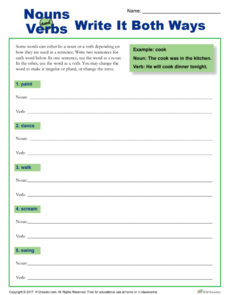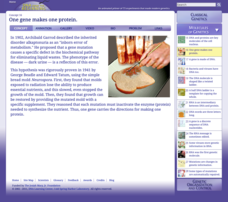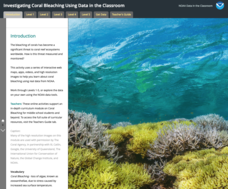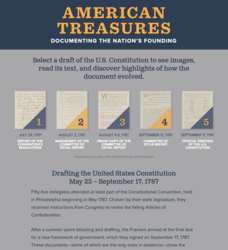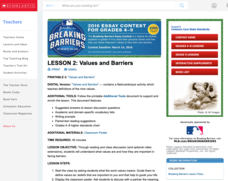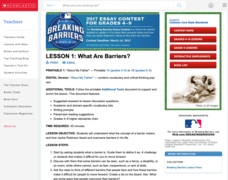K12 Reader
Nouns Verbs: Write it Both Ways
A five-item worksheet challenges scholars to write two sentences using the same verb in two different ways—as a noun and a verb.
K12 Reader
Identifying Conjunctive Adverbs
Conjunctive adverbs can connect two independent clauses like grammar magic! A short review activity prompts students to find and circle the conjunctive adverbs in each sentence.
K12 Reader
Conjunctive Adverbs and Independent Clauses
Conjunctive adverbs are not conjunctions, but they can function as conjunctions when paired with appropriate punctuation. If that's too complicated for language arts students, have them work on an activity that provides a word bank of...
Skills Workshop
Rosa Louise Parks
One moment can define the rest of your life—and in the case of Rosa Parks and her famous decision in December 1955, it can define the trajectory of a nation. Elementary readers learn more about the life and message of Rosa Parks with an...
Physics Classroom
Momentum
Interactive emphasizes understanding magnitude of momentum vectors depends upon mass and velocity, while the direction of the vector only relates to the direction of movement. As part of the larger series on momentum and collision, three...
Perfection Learning
In The Year of the Boar and Jackie Robinson - Activity Book
Moving to a new country isn't easy, as Shirley Temple Wong learns in In The Year of the Boar and Jackie Robinson by Bette Bao Lord. A series of language arts activities carry readers through the novel, addressing the story's themes,...
Cold Spring Harbor Laboratory
One Gene Makes One Protein
Very few universities still offer a master's degree in the ecology of grasses, but that was the degree that led George Wells Beadle to an interest in genetics and later a Nobel Prize. Scholars learn about the discoveries of Dr. Beadle...
Cold Spring Harbor Laboratory
Mendelian Genetics Cannot Fully Explain Human Health and Behavior
The breakthrough of Mendelian genetics solved many puzzles for biologists. Then, scientists decided to apply the theory to human behavior. Learn the story and struggle of finding a genetic explanation for hobbies, interests, and mental...
Serendip
Golden Rice – Evaluating the Pros and Cons
More than half the world's population eats rice as a daily staple ... imagine if that rice could prevent illness. Scientists genetically engineered rice to include vitamin A for just that purpose. However, room for debate still exists....
NOAA
Investigating Coral Bleaching Using Data in the Classroom
Approximately 93 percent of the individual reefs in the Great Barrier Reef suffer from coral bleaching. Scholars learn how scientists monitor coral bleaching around the world as part of a larger series. They use actual data to answer...
NOAA
Understanding El Niño Using Data in the Classroom
Are weather troubles caused by El Nino? An installment of a larger series presents a five-part lesson on El Nino. First, scholars learn to read sea surface temperature maps. Then, they compare them to data on graphs before determining if...
Meadows Center for Preventing Educational Risk, University of Texas at Austin
Sight Word Fluency Lists 61 to 70
Every word matters. Increase reading fluency with word recognition practice. Scholars continue to practice reading words in each list until they demonstrate mastery. Readers practice both new and review word lists.
Meadows Center for Preventing Educational Risk, University of Texas at Austin
Sight Word Fluency Lists 46 to 60
Reading takes place one word at a time. Increase scholar word recognition fluency and create better readers with sight word fluency lists. Readers continue to practice each list until they prove mastery.
Meadows Center for Preventing Educational Risk, University of Texas at Austin
Sight Word Fluency Lists 31 to 45
Practice makes perfect. Scholars get a lot of practice with sight word recognition as they continue to read words from each list until they master all words. Lists offer both new and review words.
Meadows Center for Preventing Educational Risk, University of Texas at Austin
Sight Word Fluency Lists 16 to 30
Record keeping and data is essential to tracking scholar growth. Educators record pupil mastery of sight word recognition on nine pre-made sheets. Teachers and parents easily view data, progress, and word mastery.
National Constitution Center
The Development and Application of the First Amendment
What are the limits on freedom of speech? While a cherished right in the Constitution, it is not unbridled. Budding historians consider what checks should exist on this liberty using news stories, court cases, and College Board prompts.
National Constitution Center
Federalism, the Commerce Clause, and the Tenth Amendment
How do the state and federal governments relate to each other? The Constitution has a lot to say about that! Using an interactive online tool, pupils explore the Tenth Amendment. They apply their knowledge to political cartoons and news...
National Constitution Center
Voting Rights since the Fifteenth Amendment
What does it mean to have the right to vote? To what extent have interpretations of the Fifteenth Amendment changed over time? Young historians examine and analyze primary source documents, an interactive website, and historical analysis...
National Constitution Center
Civil Liberties and Rights Worldwide
How do governments differ in how they protect human rights? While the United States prides itself on its Bill of Rights, other countries have their own ways of protecting citizens' liberties. An interactive website, paired with...
National Constitution Center
American Treasures
Just how long did it take the framers to write the Constitution? What role did the drafting process play? Scholars examine various drafts from the Constitutional Convention to gain a better understanding of its formation. Interactive...
Scholastic
Lesson 3: Essay Organizer
A three-minute exercise warms-up scholars' writing abilities in order to follow a writing process that ends in an essay. The essay's topic is a barrier and the values used to break it. Four steps include choosing a topic, jotting-down a...
Scholastic
Lesson 2: Values and Barriers
Scholars investigate and discuss the importance of values and how they can be used to break barriers. Small groups work collaboratively to examine the text and draw inferences to answer questions. A writing assignment challenges pupils...
Scholastic
Lesson 1: What Are Barriers?
Scholars discuss the concept of a barrier with a short passage on Jackie Robinson. The writing process begins with a paragraph and several other sentences about Robinson's unique traits that made breaking a barrier possible.
Serendip
Understanding and Predicting Changes in Population Size – Exponential and Logistic Population Growth Models vs. Complex Reality
Salmonella poisoning impacts over 200,000 people in the United States each year. Scholars learn about the growth of these bacteria using multiple approaches. Then they apply the same growth calculations to endangered species and think...


